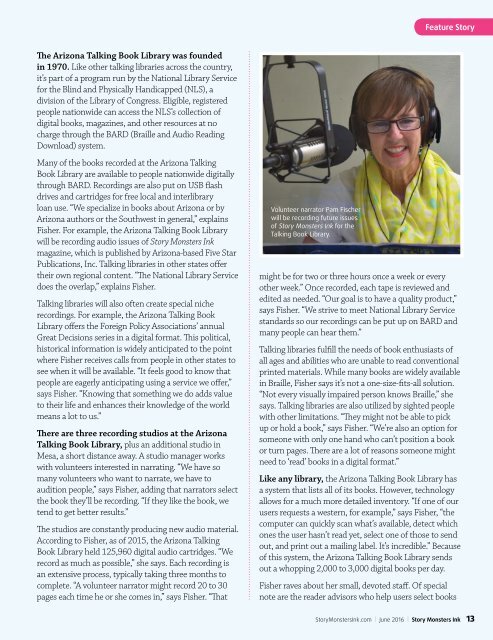Create successful ePaper yourself
Turn your PDF publications into a flip-book with our unique Google optimized e-Paper software.
Feature Story<br />
The Arizona Talking Book Library was founded<br />
in 1970. Like other talking libraries across the country,<br />
it’s part of a program run by the National Library Service<br />
for the Blind and Physically Handicapped (NLS), a<br />
division of the Library of Congress. Eligible, registered<br />
people nationwide can access the NLS’s collection of<br />
digital books, magazines, and other resources at no<br />
charge through the BARD (Braille and Audio Reading<br />
Download) system.<br />
Many of the books recorded at the Arizona Talking<br />
Book Library are available to people nationwide digitally<br />
through BARD. Recordings are also put on USB flash<br />
drives and cartridges for free local and interlibrary<br />
loan use. “We specialize in books about Arizona or by<br />
Arizona authors or the Southwest in general,” explains<br />
Fisher. For example, the Arizona Talking Book Library<br />
will be recording audio issues of Story Monsters Ink<br />
magazine, which is published by Arizona-based Five Star<br />
Publications, Inc. Talking libraries in other states offer<br />
their own regional content. “The National Library Service<br />
does the overlap,” explains Fisher.<br />
Talking libraries will also often create special niche<br />
recordings. For example, the Arizona Talking Book<br />
Library offers the Foreign Policy Associations’ annual<br />
Great Decisions series in a digital format. This political,<br />
historical information is widely anticipated to the point<br />
where Fisher receives calls from people in other states to<br />
see when it will be available. “It feels good to know that<br />
people are eagerly anticipating using a service we offer,”<br />
says Fisher. “Knowing that something we do adds value<br />
to their life and enhances their knowledge of the world<br />
means a lot to us.”<br />
There are three recording studios at the Arizona<br />
Talking Book Library, plus an additional studio in<br />
Mesa, a short distance away. A studio manager works<br />
with volunteers interested in narrating. “We have so<br />
many volunteers who want to narrate, we have to<br />
audition people,” says Fisher, adding that narrators select<br />
the book they’ll be recording. “If they like the book, we<br />
tend to get better results.”<br />
The studios are constantly producing new audio material.<br />
According to Fisher, as of 2015, the Arizona Talking<br />
Book Library held 125,960 digital audio cartridges. “We<br />
record as much as possible,” she says. Each recording is<br />
an extensive process, typically taking three months to<br />
complete. “A volunteer narrator might record 20 to 30<br />
pages each time he or she comes in,” says Fisher. “That<br />
Volunteer narrator Pam Fischer<br />
will be recording future issues<br />
of Story Monsters Ink for the<br />
Talking Book Library.<br />
might be for two or three hours once a week or every<br />
other week.” Once recorded, each tape is reviewed and<br />
edited as needed. “Our goal is to have a quality product,”<br />
says Fisher. “We strive to meet National Library Service<br />
standards so our recordings can be put up on BARD and<br />
many people can hear them.”<br />
Talking libraries fulfill the needs of book enthusiasts of<br />
all ages and abilities who are unable to read conventional<br />
printed materials. While many books are widely available<br />
in Braille, Fisher says it’s not a one-size-fits-all solution.<br />
“Not every visually impaired person knows Braille,” she<br />
says. Talking libraries are also utilized by sighted people<br />
with other limitations. “They might not be able to pick<br />
up or hold a book,” says Fisher. “We’re also an option for<br />
someone with only one hand who can’t position a book<br />
or turn pages. There are a lot of reasons someone might<br />
need to ‘read’ books in a digital format.”<br />
Like any library, the Arizona Talking Book Library has<br />
a system that lists all of its books. However, technology<br />
allows for a much more detailed inventory. “If one of our<br />
users requests a western, for example,” says Fisher, “the<br />
computer can quickly scan what’s available, detect which<br />
ones the user hasn’t read yet, select one of those to send<br />
out, and print out a mailing label. It’s incredible.” Because<br />
of this system, the Arizona Talking Book Library sends<br />
out a whopping 2,000 to 3,000 digital books per day.<br />
Fisher raves about her small, devoted staff. Of special<br />
note are the reader advisors who help users select books<br />
StoryMonstersInk.com | June 2016 | Story Monsters Ink 13


